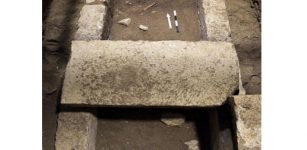Chilling Graffiti Found In 1,600-Year-Old Roman Prison In Corinth, Greece
Jan Bartek - AncientPages.com - Roman prisons were an integral part of the ancient justice system, characterized by harsh conditions designed to extract confessions from inmates. These facilities were typically dark, damp, and unsanitary, effectively isolating prisoners from the outside world. Due to the passage of time and the nature of these structures, archaeologists have faced challenges identifying the remnants of these historical incarceration sites.
Ancient city of Corinth. Credit: MM - Public Domain
Recently, Matthew Larsen, an archaeologist and assistant professor of New Testament studies at the University of Copenhagen, made a significant discovery. During his research in Corinth, Greece, Larsen uncovered what he believes to be the ruins of a Roman prison. This find is particularly noteworthy as, despite the prevalence of prisons in Roman cities, very few have been definitively identified to date.
The scientists explained that there is little doubt that these ruins are likely a former Roman prison. Larsen's study revealed floor cracks with prisoner inscriptions, confirming the site's original purpose. Evidence includes remnants of food and light sources for inmates and traces of a small sanitation area in one cell.
Larsen's findings, published in the journal Hesperia, highlight the scarcity of evidence regarding the appearance and location of Roman prisons. The Corinth site dates back to the 5th and 6th centuries AD, when Christianity spread throughout the Roman Empire, including its Greek provinces.
Interestingly, the prison walls bear inscriptions that further attest to the Christian influence of the time.
Larse found chilling graffiti written in Greek among the inscriptions, which provided insight into the prisoners' suffering.
One inscription reads, “Lord, make them die an awful death.” Other messages express similar sentiments, with pleas for divine retribution against their captors and descriptions of the prison’s harsh conditions. “May the fortune of those who suffer in this lawless place prevail. Lord, do not show mercy on the one who threw us in here,” is another example of the graffiti found.
The inscriptions also reveal prisoners' daily lives. Some graffiti shows board games, suggesting inmates played games to relieve boredom despite harsh conditions.
Incarceration conditions were harsh. Prisoner inscriptions suggest a gloomy atmosphere with unanswered pleas. Some inmates endured long confinements in cold underground cells, even through winter.
In ancient Rome, few lawbreakers were sentenced to imprisonment. Most unfortunate individuals waited in dark dungeons for their trial or execution. Sentencing to forced labor was far more popular and conducive to the empire's gigantic construction projects.
The study was published in the journal Hesperia.
Written by Jan Bartek - AncientPages.com Staff Writer





















